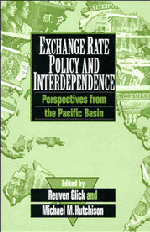Book contents
- Frontmatter
- Contents
- List of contributors
- Preface
- Exchange rate policy and interdependence
- 1 Overview
- I International financial market integration
- II Choice of exchange rate regimes
- III Intervention and sterilization policies
- IV Prospects for a yen bloc
- 13 On the possibility of a yen bloc
- 14 Economic fundamentals and a yen currency area for Asian Pacific Rim countries
- Index
14 - Economic fundamentals and a yen currency area for Asian Pacific Rim countries
Published online by Cambridge University Press: 04 May 2010
- Frontmatter
- Contents
- List of contributors
- Preface
- Exchange rate policy and interdependence
- 1 Overview
- I International financial market integration
- II Choice of exchange rate regimes
- III Intervention and sterilization policies
- IV Prospects for a yen bloc
- 13 On the possibility of a yen bloc
- 14 Economic fundamentals and a yen currency area for Asian Pacific Rim countries
- Index
Summary
Introduction
The success of a yen currency area for Asian Pacific Rim countries depends on the economic fundamentals related to the choice of a reserve currency. Central banks tend to peg to currencies because of trade and financial relationships with dominant partner countries that make intervention in a particular currency practical. In addition, a key reserve currency should offer the central bank (and private domestic market investors and firms) an attractive package of risk and return characteristics from a portfolio point of view.
We explore the role of the Japanese yen as a potential dominant reserve currency for other Asian Pacific Rim nations by focusing exclusively on the portfolio role a dominant currency must fulfill. The question we address is: If we formed a Pacific Rim currency area, which single currency would be preferred?
Our approach to answering this question is to rank the return distributions for each candidate currency from the point of view of central banks in each Pacific Rim country. The standard second–degree stochastic dominance approach to this problem typically suffers from ambiguities, so that unique rankings are not possible. We overcome this problem by taking a generalized stochastic dominance approach that enables us to determine unique rankings for various groups of risk–averse decision makers.
The fundamentals considered here do not provide much support for the idea of a yen currency area. We find that the portfolio analysis provides more support for a dominant U.S. dollar or Australian dollar than a dominant yen.
- Type
- Chapter
- Information
- Exchange Rate Policy and InterdependencePerspectives from the Pacific Basin, pp. 344 - 362Publisher: Cambridge University PressPrint publication year: 1994



